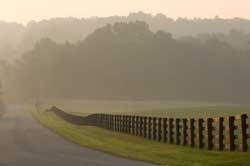To provide observations and information on the emerging fields of landscape scale conservation, heritage preservation, and sustainable community development.
Newsletter
Stay up-to-date with the latest nature, culture and community news.
We won’t spam you or share your information. Newsletters are sent approximately 10 times a year. Unsubscribe at any time.

Take Notice: Trending for Large Landscapes
Every two years protected area managers, scientists, and every kind of experts on cultural and natural heritage gather at the George Wright Conference to present papers, engage in lively discussions and swap professional gossip at the bar. I always find these meetings to be the place to spot emerging ideas in the field. The 2017 meeting in Norfolk VA was no exception. So what is trending for large landscapes?

Examining Federal Land Acquisition Practices After World War II
In the decades after World War II, the Federal government significantly altered its approach to land acquisition for parks, forests and other protected areas. Before this

Federal Budget: First Look is not Promising
On March 16, 2017 the Whitehouse released its budget framework styled America First: A Budget Blueprint to Make America Great Again and the news was not great for programs that support large landscape conservation. For the FY 2018 the Department of Interior faces a proposed 12 % budget reduction and the Environmental Protection Agency is facing a 31% reduction. In general this brief document does not identify where the pain will fall except on the often pummeled National Heritage Areas. And while only the first step in the budget process, this proposal needs to be taken seriously.

Thinking About Heritage Tourism
With a global market of 1 billion travelers, how can heritage managers draw more travelers into a deeper engagement around the understanding of place and more importantly the people who live in a place. Can another approach the found that goes beyond just consumer driven products sometimes characterized as hit and run tourism? A recent conference and a visit to two World Heritage cities, provided an opportunity for reflection.

Featured Voices – Interviews with Landscape Practitioners and Scholars
Last month we added a new element to the Living Landscape Observer – Featured Voices. Going forward, each issue will highlight the work, experiences and perspective of an individual involved in the practice of landscape conservation or the study of large landscapes. Our interviewees will come from academia, the public sector, nonprofit organizations and business- all with the ultimate goal of sharing knowledge and insights into this complex and growing field.

Take Notice: Trending for Large Landscapes
Every two years protected area managers, scientists, and every kind of experts on cultural and natural heritage gather at the George Wright Conference to present papers, engage in lively discussions and swap professional gossip at the bar. I always find these meetings to be the place to spot emerging ideas in the field. The 2017 meeting in Norfolk VA was no exception. So what is trending for large landscapes?

Examining Federal Land Acquisition Practices After World War II
In the decades after World War II, the Federal government significantly altered its approach to land acquisition for parks, forests and other protected areas. Before this

Federal Budget: First Look is not Promising
On March 16, 2017 the Whitehouse released its budget framework styled America First: A Budget Blueprint to Make America Great Again and the news was not great for programs that support large landscape conservation. For the FY 2018 the Department of Interior faces a proposed 12 % budget reduction and the Environmental Protection Agency is facing a 31% reduction. In general this brief document does not identify where the pain will fall except on the often pummeled National Heritage Areas. And while only the first step in the budget process, this proposal needs to be taken seriously.

Thinking About Heritage Tourism
With a global market of 1 billion travelers, how can heritage managers draw more travelers into a deeper engagement around the understanding of place and more importantly the people who live in a place. Can another approach the found that goes beyond just consumer driven products sometimes characterized as hit and run tourism? A recent conference and a visit to two World Heritage cities, provided an opportunity for reflection.

Featured Voices – Interviews with Landscape Practitioners and Scholars
Last month we added a new element to the Living Landscape Observer – Featured Voices. Going forward, each issue will highlight the work, experiences and perspective of an individual involved in the practice of landscape conservation or the study of large landscapes. Our interviewees will come from academia, the public sector, nonprofit organizations and business- all with the ultimate goal of sharing knowledge and insights into this complex and growing field.


